Following the trip report posted earlier, we give you the list of birds sighted by the team consisting of KC Tsang, Amy Tsang and Willie Kwek.
Appendix A: Birds Sighted (Note: Bird names with an asterisk indicate those that were more unusual for us).
25-27 & 30-31May 09: Sepilok Forest Edge Resort – garden/ lotus lake area
1. *Ruby Cheeked Sunbird (male & female)
2. Chestnut Munia (many on grass and nesting in small trees)
3. Tree Sparrows (as many as Ch Munias – has long tail)
4. Emerald Dove (1)
5. Crimson Sunbird (Saw 2 times, male & female)
6. Olive-Backed Sunbird (a few)
7. Yellow-Vented Bulbuls (several/2 juveniles sitting alongside)
8. Magpie Robin (several – adult and youngster)
9. Pied Fantail Flycatcher (one nest spotted)
10. Glossy Tree Starlings (several)
11. White-Bellied Sea Eagle 
12. Brahminy Kite
13. Raffles Malkoha (male & female)
14. *Rufous-fronted Babbler (a few)
15. Plaintive Cuckoo (sighted & photographed; heard only on 30/5) (right)
16. Banded Bay Cuckoo (heard only?)
17. White-Collared Kingfisher
18. *Green Iora (2 outside ‘Agnes Keith’ chalet)
19. *Black and Red Broadbill (1 adult & one nest spotted)
20. Long-Tail Parakeet (several)
21. Pacific Swallow (several)
22. White-Breasted Waterhen (several in & abt Lotus pond)
23. Pink-Necked Pigeon (a few)
24. Jungle Crow (a few)
25. Rufous -Tailed Tailorbird
26. Large-Tailed Nightjar
27. Chestnut-Breasted Malkoha
26 May 09: Rainforest Discovery Centre
1. Pink-Necked Pigeon (a few)
2. Green Iora
3. Olive-Winged Bulbul
4. Yellow-Vented Bulbul
5. Bat Hawk (1 around the Hornbill Tower area )
6. *Scarlet-Rumped Trogon (along Kingfisher trail)
7. *Monarch Blue Flycatcher (along Kingfisher trail)
8. Little Spiderhunter (along Kingfisher trail)
9. Brahminy Kite
10. Hairy-Backed Bulbul (a few along Kingfisher trail)
11. Raffles Malkoha
12. Rufous-Tailed Tailor Bird
13. Magpie Robin
14. Pied Fantail Flycatcher (a few, one nesting by lake)
15. Changeable Hawk Eagle
16. White-Collared Kingfisher
27 May 09: Forest Edge Resort jungle trail
1. *Fluffy-Backed Tit-Babbler (a few)
2. *Black-Throated Babbler (Adult & Juvenile)
3. Little Spiderhunter
4. Pied Fantail Flycatcher
5. White-Breasted Waterhen
6. Plaintive Cuckoo (female & juvenile)
7. Greater Green Leafbird
8. Lesser Green Leafbird (male & female)
9. Rufous-Tailed Tailor Bird
10. Chestnut Munia
11. Tree Sparrow
12. White-Bellied Sea Eagle
13. Brahminy Kite
14. Olive-Winged Bulbul
15. White-Collared Kingfisher
16. Wreathed Hornbill (heard only)
17. Brown Hawk Owl (heard only)
18. Diard’s Trogon (heard only)
19. Ruby-Cheeked Sunbird (female only)
20. Yellow-Vented Bulbul
21. Magpie Robin
22. Greater Racket-Tailed Drongo (1 only)
23. Raffles Malkoha
Other interesting sightings
KC collected a lovely Argus Pheasant feather while on the jungle trail (left). Willie and Amy witnessed 2 leeches on a leaf entwining each other, which turned out to be the foreplay before the act of copulation and sperm transfer. Willie managed to photograph the foreplay activity of the leeches. Attached below for easy reference is an interesting piece about leeches taken from the Internet:
Leeches are hermaphrodites, meaning they are organisms that have both female and male reproductive organs (ovaries and testes respectively). They reproduce by reciprocal fertilization and sperm transfer occurs during copulation.The leech exercising the role of the male will grow a sperm sack near the end of their tail, and the leech playing the female will bite it off, thus reproducing. Similarly to the earthworms, leeches also use a clitellum to hold their eggs and secrete the cocoon.
During reproduction leeches utilize hyperdermic injection of their sperm. They use a spermatophore which is a structure containing the sperm. Once next to another leech, the two will line up with their
anterior side opposite the others posterior. The leech then shoots the spermatophore into the clitellur region of the opposing leech where its sperm will make its way to the female reproductive parts.
28 May 09: Kinabatangan Jungle Camp
We had a river boat cruise in the afternoon from 3.30-6.30pm and a night cruise from 8.30-10.30pm. Weather permitting, boat cruises in the day and night are the norm for stays at the camp.
PM cruise: For nearly all of the time, we explored the narrow inlet close by to our camp. Birdingwise, it was quite fruitful even though we could see the oil palm estate for some parts of the way.
1. Crested Serpent Eagle ( one seen sitting on wire pole at camp, and the other sighted on river boat cruise)
2. White-Crowned Sharma (a few sighted at camp site)
3. Chestnut-Winged Babbler
4. Pacific Swallow
5. Storm Stork #
6. White-Bellied Sea-Eagle
7. Brahminy Kite
8. Chestnut Munia
9. Black & Red Broadbill
10. Chestnut Breasted Malkoha
11. Blue-Eared Kingfisher
12. Brown Hawk Owl (heard only)
13. Malaysian Blue Flycatcher (female only)
14. Dollar Bird
15. Oriental Darter (several) (above)
16. Green Imperial Pigeon (several)
17. Lesser Fish-Eagle
18. Grey-Headed Fish-Eagle
19. Egret (small, median, large – frequently sighted on river banks) 
20. Little Green Pigeon (several)
21. Stork-Billed Kingfisher
22. Blue-Crowned Hanging Parrot
23. Plaintive Cuckoo
24. Pied Hornbill
25. Wrinkled Hornbill (right)
26. Black Hornbill (Male & Juvenile) (above right)
27. Rhinocerous Hornbill
28. Blue-Throated Bee-Eater
29. Purple Heron (a few)
30. Black-Crowned Night Heron
31. Hill Mynah
# We first sighted 2 Storm Storks on a tree close by the main road which we traveled upon in our land journey to Kg Bilit.
Other sightings:
1 Black Squirrel with chestnut belly spotted at camp area before we
set off for the cruise.
2 A band of female Proboscis monkeys in a tree with young amongst
them.
3 One black/yellow banded Mangrove Snake spotted sleeping on a tree during our cruise.
Night cruise
Observations: All the birds were sleeping – some more soundly than others except for the owls. Our guide, Rusmil, went close enough to stroke one sleeping Blue-Eared Kingfisher which had its head tucked into its body. It seemed to be in a deep stupor, and whilst it lifted its head up after the stroking, it did not wake up and continued sleeping with its head facing upwards!
1. Blue-Eared Kingfisher (right)
2. Black & Red Broadbill (saw 3 birds snuggled together – our proximity disturbed them and they flew away; subsequently we saw another 3 more but these continued to sleep on happily)
3. Pied Fantail Flycatcher (fantail was closed in a straight and stiffened manner whilst the bird was sleeping)
4. Buffy Fish Owl (saw 2 and these were hunting; one was photographed with a half eaten rat in its talons)
Other sightings
Two estuarine crocodiles were sighted – one was a juvenile and the other was medium size.
29 May 09: Kinabatangan Jungle Camp, AM cruise:
Explored narrow inlet close by to our camp for the most part.  1 Lesser Fish Eagle
1 Lesser Fish Eagle
2 Wallace’s Hawk Eagle
3 Crested Serpent Eagle
4 Crested Goshawk
5 Changeable Hawk Eagle (heard only)
6 Oriental Darter (several)
7 Storm Storks (counted 7 for the morning) #
8 Asian Paradise Flycatcher (1 female)
9 Blue-Eared Kingfisher
10 Ruddy Kingfisher (heard only)
11 Stork-Billed Kingfisher
12 White-Chested Babblers (a few) (above right)
13 Monarch Blue Flycatcher (1)
14 Egret (small, median, large)
15 Hooded Pitta (heard) 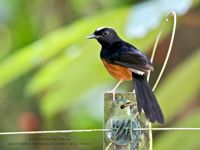 16 White-Crowned Hornbill (heard only)
16 White-Crowned Hornbill (heard only)
17 Pied Hornbill (several)
18 Wrinkled Hornbill (saw 2 of them)
19 Black Hornbill (several)
20 Common Cormorant (?)
21 Pacific Swallow
22 Green Imperial Pigeon
23 White Crowned Sharma (right)
24 Jungle Crow
25 Drongo Cuckoo
26 Black & Crimson Oriole
27 Black & Red Broadbill (heard only)
28 Dollar Bird (several)
29 Purple Heron
Animals sighted
1 40 Pygmy Elephants
2 1 large Gibbon
3 1 Bearded Pig (seemed quite light coloured)
4 1 Creamy Giant Squirrel
PM Cruise
We went to the Ox Bow lake area for the most part. Seemed to be less fruitful, birdingwise.
1 Bat Hawk (2 on tree with large nest )
2 Pied Hornbill ( several)
3 Rhinocerous Hornbill (1 only)
4 Black Hornbill
5 Wrinkled Hornbill
6 White-Fronted Falconet
7 Egret (small, median, large)
8 Chestnut Breasted Malkoha
9 Stork-Billed Kingfisher
10 Green Imperial Pigeon
11 Oriental Darter
12 Brahminy Kite
13 Dollar Bird
14 Woodpecker (very small – Grey-CappedWoodpecker?)
15 Woodpecker (larger size – could not identify as too far away)
16 Wallace’s Hawk Eagle
17 Pied Imperial Pigeon
18 Purple Heron
Animals sighted
1 Orang Utan (1 large male up in a big tree)
2 Proboscis Monkey (1 large male with his harem which included 6-7 females, plus 6 youngsters)
3 Pig-Tailed Macque (1 large one only – also on a tree)
4 Long-Tailed Macques (several)
5 Crocodile (1 only)
30 May 09: Kinabatangan Jungle Camp, AM Cruise
This final cruise for the trip was led by Robert Chong, who tried hard to show us the Ground Cuckoo through mimicking its call, but it was to no avail. The bird simply refused to show itself to us! We spent most of the time on a small tributary not far from Sukau Lodge, though earlier on we had also visited the inlet close to our camp.  1 Common Iora
1 Common Iora
2 White-Crowned Sharma
3 Oriental Darter
4 Lesser Fish Eagle
5 Pied Hornbill
6 Greater Coucal
7 Black Hornbill
8 Blue-Eared Kingfisher
9 Stork-Billed Kingfisher
10 Mangrove Blue Flycatcher
11 Malaysian Blue Flycatcher (heard only) (right)
12 White-Chested Babbler (heard only)
13 Black-Capped Babbler
14 Crested Fireback Pheasant
15 Scarlet-Rumped Trogon
16 Black & Yellow Broadbill
17 Black & Red Broadbill
18 Drongo Cuckoo
19 Bat Hawk (in flight – looks like bat man!)
20 Crested Serpent Eagle
21 Chestnut-Breasted Malkoha
22 Egret (small, median, large)
23 Striated Heron (one only)
24 Dark-Necked Tailor Bird
25 Blue-Eared Barbet (heard only)
26 Wood Swallow
27 Pacific Swallow
28 Chestnut Munia
29 Glossy Tree Starling
30 Spotted Dove
31 Jungle Crow
32 Grey-Cheeked Bulbul
33 Red-Eyed Bulbul
34 Striped Tit Babbler (heard only)
35 Hooded Pitta
36 Banded Bay Cuckoo
37 Dollar Bird
38 Purple Heron
39 Pied Fantail Flycatcher
40 Storm Stork (many seen on cruise on tree/in flight. We also had a close sighting of one small-sized solitary storm stork at our camp site. The camp cook fed the storm stork with some meat. The large Monitor lizards also came to look for food at the same time, and tried to steal from the Storm Stork’s share.)
Animals sighted
1 Wild Boar
2 Bearded Pig? (Very pink in colour though)
3 Black Squirrel
4 Proboscis Monkey
5 Long-Tailed Macque
6 Monitor Lizard
Insect Encounters – Butterflies, Moths, Dragonfly
1 Hawk Moth – Marumba Juvenus
2 Butterfly – Forest White (Udaiana cynis) Not uncommon pieridie at forest edge.
3 Butterfly – Clipper (Parthenos Sylvia)
4 Dragonfly – Gynacantha dohmi. Info from Luan Keng – “Until last year, this species was known to occur in Borneo, Java, Sumatra and the Phillippines only. Last year, they started recording it in Singapore, and found it was quite widespread in Singapore.”
5 We saw a few stick insects flying in the jungle when we were birding.
KC Tsang, Amy Tsang & Willie Kwek
Singapore
June 2009


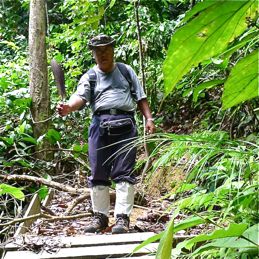
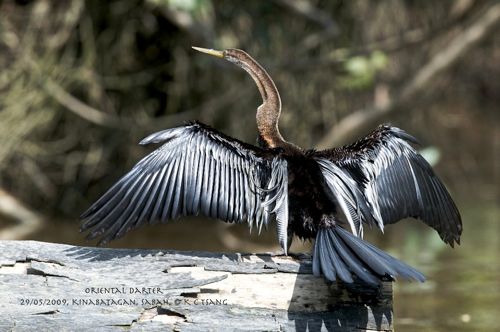
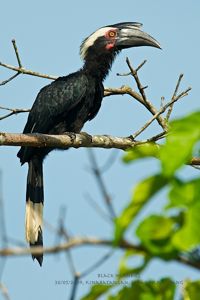
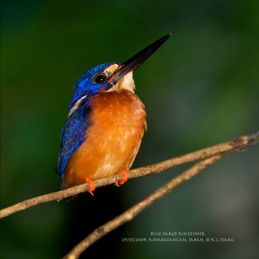







2 Responses
I’ve always wanted to at least try attempting bird watching, but I don’t know if what is required…like if I need an encyclopedic knowledge of birds, if I need a guide, binoculars, or any other material.
Either way, considering I’ve heard people birdwatching, it’s something that has at least made me curious.